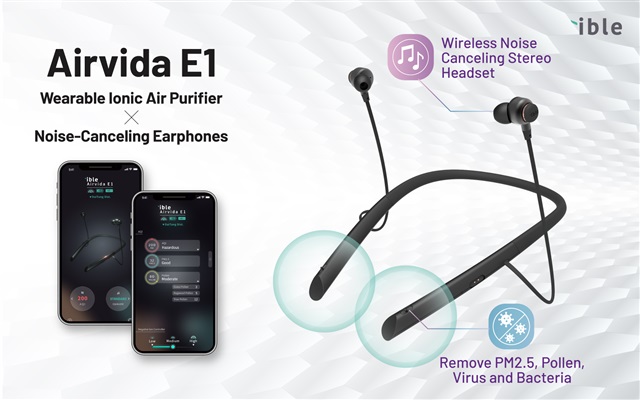Heated development of global industry coupled with rapid growth in volume of automobiles and motorcycles have made life more convenient, the cost has been increasingly serious air-pollution problems. That is why more consumers are placing air purifiers in homes and offices to reduce allergies and coughing caused by airborne particles. In recent years, thanks to the advances in semiconductor manufacturing, wearable air purifiers are now on the market. These products allow consumers to enjoy good, clean air and reduce the discomfort caused by airborne allergens no matter where they are. Many brands have launched products directly in response to the pandemic that claim to filter or remove COVID-19 viral particles, so as to reduce the chance of infection.
If you look at wearable air purifiers from a technical point of view, these products can be divided into two categories: those that use traditional high-efficiency particulate air (HEPA) filtration and those using negative-ion purification technology. Products using traditional HEPA technology rely on high-efficiency motors so as to draw in and filter a large amount of air in a short period of time. That means that such products are not very small volume-wise; it also means vibration and noise problems that are difficult to ignore. And besides having those basic issues, HEPA products may not be able to achieve instant air purification around the face.
Fred Chien, CEO of ible Technology, said that current mainstream technology of wearable air purifiers is negative ion purification technology. Negative ions are atoms, atomic groups, or molecules carrying a negative charge, whereas most of the harmful suspended particles in the air carry a positive charge. When the two meet, the harmful suspended particles in the air quickly fall before they are able to be inhaled and harm and impact human health. While it is true that negative-ion generation technology differs by brand, the real key is the transmission distance. If the negative ions cannot reach the mouth and nose, purification cannot be achieved as intended. And if the negative-ion generation method is not optimized, it can generate a large amount of ozone, which may in turn pose potential risks to human health.
The world's first lightweight purification product was created in response to real air pollution problems
ible Technology was founded in 2015. When the team members were on a business trip in China, some team members experienced serious physical discomfort due to the local air pollution. It was then that they had the idea of developing a wearable air purifier. A number of enthusiasts entered the IoT and smart wearable product fields through the establishment of ible Technology, and they launched the world's first lightweight wearable air purifier, "Airvida," in 2016.
Airvida has won the highest award in the National Biotechnology and Medical Care Quality Award & Symbol of National Quality (SNQ)* for four consecutive years, offering more than enough proof that it has the ability to remove COVID-19 virus, pollen, and air pollutants. Airvida has also earned the recognition and attention of the "2020 and 2023 CES Innovation Awards," "2022 Taiwan Excellence Award," and the 2021 Japan "Good Design" award.
"In our entrepreneurial process that year, the team started from the concept of minimizing the size of in-car air purifiers, so the product originally used HEPA filtration technology. But it did not take long to see the problems with HEPA, such as large volume, noise, vibration, and filtration effects. Existing technology was just not up to the job." Fred Chien explains: "So the team invested in R&D for negative ion technology, which would be the core of development of wearable air purifiers. It took a total of 18 months and 23 internal revisions and restarts before the first Airvida was successfully launched."
Outstanding international achievements in Germany and Japan
In the early stage of Airvida product design and development, ible Technology, familiar with the global market, decided first to enter flagship markets such as Germany and Japan. The German government has one of the strictest product review processes in the world. If a product can be sold there, it will be far easier to sell that product in the Japanese and Southeast Asian markets. As expected, just as Airvida passed the German review and went on the market, its review time in Japan dropped from the 18 months, which is common, to just about 3 to 6 months. Airvida is currently sold in more than 10 countries, including Germany, Japan, Taiwan, Singapore, Switzerland, and Thailand. In 2023, ible Technology is set to officially enter the North American market.
In the startup process, ible Technology received assistance from many sources, such as R&D subsidies from the Taipei City Government; it also participated in CES in the US with the assistance of TTA and won the recognition of two CES Innovation Awards. When entering the Japanese market in 2017, the company had the assistance of the Bureau of Foreign Trade (under the MOEA) to place product advertisements on electronic billboards on the outer wall of the Shibuya Building. This greatly helped to enhance company exposure and product popularity.
In light of the fact that Bluetooth headsets have become indispensable in consumers' lives, ible Technology will launch two wearable air purifiers that combine Bluetooth headset functionality in 2023, these being the Airvida E1 & Airvida T1. The Airvida T1, which is expected to be launched in the second half of the year, was also recognized by the "CES (Consumer Electronics Show) 2023 Innovation Awards". This award places extra emphasis on the incredible R&D capabilities of ible Technology.

ible Technology will launch Airvida E1, a wearable air purifier that combines Bluetooth noise-canceling headphone functionality, in the second half of 2023
Photo: Company



